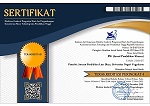Intervensi berbasis musik untuk meningkatkan kemampuan komunikasi anak dengan gangguan spektrum autisme: studi meta analisis
Ananta Yudiarso, Universitas Surabaya
Abstract
Keywords
Full Text:
PDFReferences
Anderson, D. K., Lord, C., Risi, S., DiLavore, P. S., Shulman, C., Thurm, A., Welch, K., & Pickles, A. (2007). Patterns of growth in verbal abilities among children with autism spectrum disorder. Journal of Consulting and Clinical Psychology, 75(4), 594–604. https://doi.org/10.1037/0022-006X.75.4.594
Berger D. (2002). Music therapy, sensory integration and the autistic child. Jessica Kingsley Publishers.
Chenausky, K., Norton, A., Tager-Flusberg, H., & Schlaug, G. (2016). Auditory-motor mapping training: Comparing the effects of a novel speech treatment to a control treatment for minimally verbal children with autism. PLoS ONE, 11(11), 1–22. https://doi.org/10.1371/journal.pone.0164930
Cohen, J. (1988). Statistical power analysis for the behavioral sciences (2nd ed.) (N. . Hillsdale (ed.)). Erlbaum Associates.
Gattino, G. S., dos Santos Riesgo, R., Longob, D., Leite, J. C. L., & Faccini, L. S. (2011). Effects of relational music therapy on communication of children with autism: A randomized controlled study. Nordic Journal of Music Therapy, 20(2), 142–154. https://doi.org/10.1080/08098131.2011.566933
Goyal, A. K., Yadav, G., & Yadav, S. (2012). Music therapy : a useful therapeutic tool for health , physical and mental music therapy : a useful therapeutic tool for health , physical and mental growth. International Journal of Music Theraphy, 2(1–2), 13–18.
Hadjikhani N, Joseph RM, Snyder J, et al. (2006). Anatomical differences in the mirror neuron system and social cognition network in autism. Cerebral Cortex, 16(9), 1276–1282.
Herbert MR, Harris GJ, Adrien KT, et al. (2002). Abnormal asymmetry in language association cortex in autism. Annals of Neurology, 52(5), 588–596.
Hermawan. (2019). Tiga Terapi untuk Anak Autisme. https://www.tagar.id/tiga-terapi-untuk-anak-autisme
Ho, Y. C., Cheung, M. C., & Chan, A. S. (2003). Music training improves verbal but not visual memory: Cross-sectional and longitudinal explorations in children. Neuropsychology, 17(3), 439–450. https://doi.org/10.1037/0894-4105.17.3.439
J. Hughes, Y. Daaboul, J. Fino, G. L. S. (1998). The Mozart effect Epileptiformactivity. ClinElectroencepha Logr, 29 (3), 109.
Jing L., W. X. (2008). Evaluation on the effects of relaxing music on the recovery from aerobic exercise-induced fatigue. J Sports Med Phys Fitness, 48 (1), 102–106.
Just MA, Cherkassky VL, Keller TA, et al. (2004). Cortical activation and synchronization during sentence comprehension in high-functioning autism: Evidence of underconnectivity. Brain : A Journal of Neurology, 127, 1811–1821.
Kahn, L., Haldane, E. S., & Ross, G. R. T. (2012). The philosophical works of descartes. The Journal of Philosophy, Psychology and Scientific Methods, 11(7), 189. https://doi.org/10.2307/2013718
kemenpppa. (2018). Hari peduli autisme sedunia: kenali gejalanya, pahami keadaannya. https://www.kemenpppa.go.id/index.php/page/read/31/1682/hari-peduli-autisme-sedunia-kenali-gejalanya-pahami-keadaannya
Koelsch S, Gunter TC, Wittfoth M, et al. (2005). Interaction between syntax processing in language and in music: An ERP Study. Journal of Cognitive Neuroscience, 17(10), 1565–1577.
Kolko, D. J., Anderson, L., & Cambell, M. (1980). Sensory preference and overselective responding in autistic children. Journal of Autism and Developmental Disorders, 10, 259–171.
LaGasse, A. B. (2014). Effects of a music therapy group intervention on enhancing social skills in children with autism. Journal of Music Therapy, 51(3), 250–275. https://doi.org/10.1093/jmt/thu012
Lim, H. A. (2010). Effect of “developmental speech and language training through music” on speech production in children with autism spectrum disorders. Journal of Music Therapy, 47(1), 2–26. https://doi.org/10.1093/jmt/47.1.2
Lim, H. A., & Draper, E. (2011). The effects of music therapy incorporated with Applied Behavior Analysis verbal Behavior approach for children with autism spectrum disorders. Journal of Music Therapy, 48(4), 532–550. https://doi.org/10.1093/jmt/48.4.532
Molnar-Szakacs, I., & Heaton, P. (2012). Music: A unique window into the world of autism. Annals of the New York Academy of Sciences, 1252, 318–324.
Petrides, M. (2013). Neuroanatomy of language regions of the human brain. Elsevier Science.
Reschke-Hernández, A. E. (2011). History of music therapy treatment interventions for children with autism. Journal of Music Therapy, 48(2), 169–207. https://doi.org/10.1093/jmt/48.2.169
Rizzolatti G, A. M. (1998). Language within our grasp. Trends Neuroscience, 21, 188–194.
Rojas DC, Bawn SD, Benkers TL, et al. (2002). Smaller left hemisphere planum temporale in adults with autistic disorder. Neuroscience Letters, 328(3), 237–240.
Sandiford, G. A., Mainess, K. J., & Daher, N. S. (2013). A pilot study on the efficacy of melodic based communication therapy for eliciting speech in nonverbal children with autism. Journal of Autism and Developmental Disorders, 43(6), 1298–1307. https://doi.org/10.1007/s10803-012-1672-z
Sharda, M., Tuerk, C., Chowdhury, R., Jamey, K., Foster, N., Custo-Blanch, M., Tan, M., Nadig, A., & Hyde, K. (2018). Music improves social communication and auditory–motor connectivity in children with autism. Translational Psychiatry, 8(1). https://doi.org/10.1038/s41398-018-0287-3
Stessman, H. A. F., Xiong, B., Coe, B. P., Wang, T., Hoekzema, K., Fenckova, M., Kvarnung, M., Gerdts, J., Trinh, S., Cosemans, N., Vives, L., Lin, J., Turner, T. N., Santen, G., Ruivenkamp, C., Kriek, M., Van Haeringen, A., Aten, E., Friend, K., … Eichler, E. E. (2017). Targeted sequencing identifies 91 neurodevelopmental-disorder risk genes with autism and developmental-disability biases. Nature Genetics, 49(4), 515–526. https://doi.org/10.1038/ng.3792
Thompson, G. A., Mcferran, K. S., & Gold, C. (2014). Family-centred music therapy to promote social engagement in young children with severe autism spectrum disorder: A randomized controlled study. Child: Care, Health and Development, 40(6), 840–852. https://doi.org/10.1111/cch.12121
DOI: https://doi.org/10.21831/jpk.v18i2.42442
Refbacks
- There are currently no refbacks.
Copyright (c) 2022 JPK (Jurnal Pendidikan Khusus)

This work is licensed under a Creative Commons Attribution-ShareAlike 4.0 International License.
Supervised by:
Our Journal has been indexed by:

JPK (Jurnal Pendidikan Khusus) is licensed under a Creative Commons Attribution-ShareAlike 4.0 International License.
Based on a work at https://journal.uny.ac.id/index.php/jpk.







